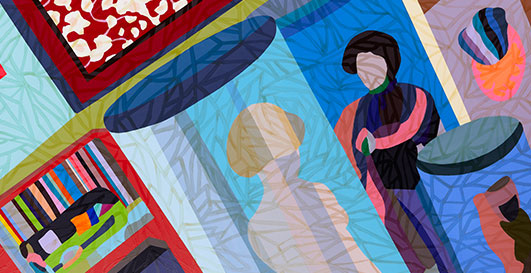
Cyroulnik

About loss
At the end of Orson Welles’ Citizen Kane, a small snow globe falls from the main character’s inanimate hand while snow falls over the landscape of his kitsch fantasies to the tolling of dreams that will no longer see the day. This is in a way what is suggested by Carolina Antoniadis’ works. They cast a melancholic light that shapes the figures, objects and motifs of a lost world. Her lights, colors and shapes are the echo of a contemporary Arcadia where the heroine would have been banished. Dreams of modernity and shoddy objects structure the universe of her work and her exhibition at the Del Infinito Arte art gallery.
In her paintings, it is easy to see the rearticulation of the pop language that is present in the popular culture and the icons of our everyday life, the raw materials of her work. However, what might be more interesting to point out is the way she is inspired by Matisse for his desire to formalize figures and by Klimt for his way of dissolving the figure inside the decorative motif and vice versa.
Considering this, we cannot but underline the atypical and outstanding place that this work enjoys in the Argentina’s art scene: in the tableaux de la vie moderne that the artist offers us, her work highlights the tragic reality of a world where the dead comes to life. She stands out in the art of recycling the most anodyne images and the most insignificant objects and to transform them in metonymic figures of lives and happy moments that passed away or were interrupted, and which time and oblivion had covered with a film to transfer them upon things.
It is not by chance that Carolina Antoniadis has taken an interest in decorative arts and particularly in pottery, objects or even textile design. Also, it is not random that she is particularly fond of Jugendstijl and Art Nouveau, where decorative and arabesque patterns invade and transform the utilitarian space.
She likes to play with objects as if they were a palette; she can make a motif out of a whole image and she assumes with clarity the fluctuation between the singularity of her work and its multiplication in the usual object. But she also knows how to distinguish the scenographic or allegorical potentialities hidden in the objects.
Of strokes and color
The characters in her paintings are defined by their contours but can never be identified as a person. They are both particular and anonymous at the same time – a mother and her son, women. The stroke also confirms the figure as a character and covers it with abstract and decorative motifs. By resorting to linear motifs and color to depict a figure, it loses its mimetic value. Here, color contaminates the realism of portrayal and imagery. Artificial colors are used in the images – colors of plastic years and of objects with a due-date that are as swift as a summer song.
Que reste-t-il de nos amours
Her paintings portray figures that bear the affectation typical of shop-window dummies frozen in a mock of a human gesture. But objects meet the same fate.
In this kitsch world full of trinkets of such a bad taste that borders on magic, they shine in all their artifice and bazaar glitter to shed a light on the dreams of a frivolous girl, or to act as stigmatized reminders of a life that is gone, objects that are cherished the most when wrapped in the shroud of time.
It is in this way where Carolina Antoniadis’ paintings take us: both to the disenchanted cynicism of a pop image and to the melancholic conscience that the dreams of modernity broke over the cliffs of mundane life.
Parables
However, her art is also about inverting the very objects and the shop-windows we found in stores with an extremely parabolic sense. For them to come to life we cannot help but remembering the passages photographed by Atget in Paris and, as Walter Benjemin mentioned, they linked the very objects to the desire brought about by the generalized mercantile exchange.
The light from the spotlights cast a shadow of the star, the moment of a fantasy, of an image or a song such as the one that endlessly repeats the refrain « j’aurais voulu être un artiste»
The palette and the objects
The objects here work as an exhibition of the shapes and motifs depicted, but also as the strokes brought from a voyage that have been abridged to a series of motifs.
They decline the multiple figures of the contemporary picturesque style. Plates, statuettes, toys, handkerchiefs and other headscarves pile up on the shelves of the emotional and sentimental bazaar. Their fragments are like pieces of papers cut out of reality. They decompose the world and, more precisely, they shatter the world of objects into pieces. From the figures of ecstasy and suffering there’s nothing left but figurines. Feelings and living things are arrested within the object. Life itself is nothing but a reduced model. Only decoration and furniture is left. And the brilliant light that for a moment irrigates the lifeless shapes sends us the shining of a lost world where things were incarnated.
Out of the mass of figures pulled out from the representation, there is nothing left but anodyne silhouettes shaped by line and color. They make them emerge and they dissolve themselves in the kaleidoscope of painting.
